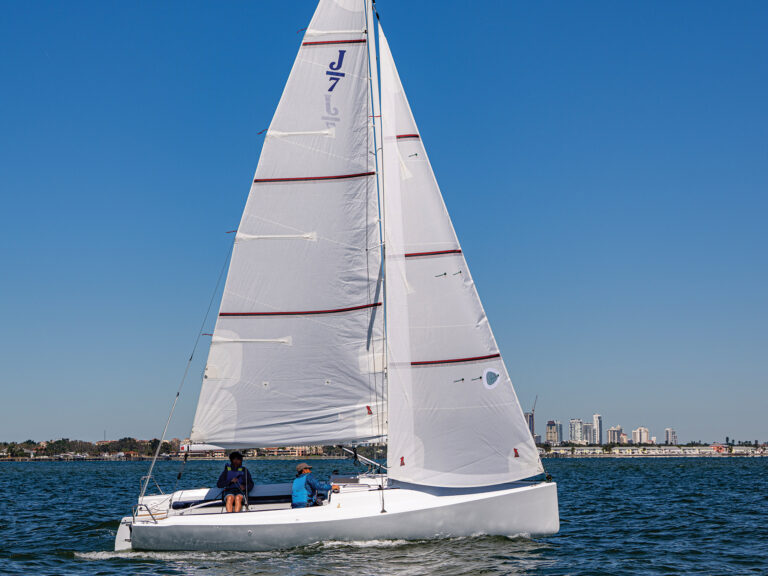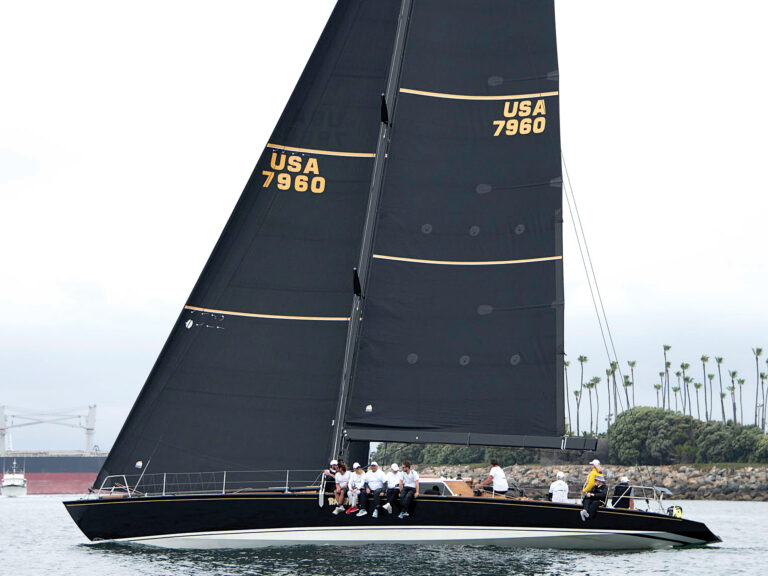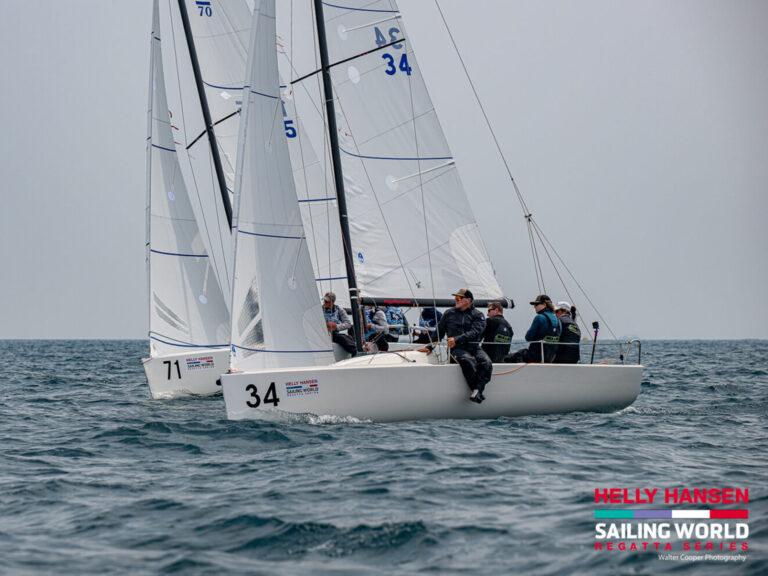
FirstBeatRileySt
It’s not so long ago that the America’s Cup was an exclusive boys’ club. While Dawn Riley wasn’t the first to break through, she has had a more significant impact on the Cup than any of the females that preceded or followed her. She won the Cup with Bill Koch in 1992 and in April she’ll lead a syndicate, Areva Challenge, into the Louis Vuitton Cup for the second time. It could also be her last, says the 42-year-old Detroit native.While our interview with Dawn was scheduled well in advance, the timing seemed quite fortuitous. Just days before the interview, Areva Challenge came out on the wrong end of a jury decision for being in possession of photographs, of Luna Rossa’s ITA-94, taken by a free-lance photographer from inside the prescribed 200-meter barrier. However, Riley told us she wasn’t at liberty to comment on the decision or the penalty-a reduction in the team’s sail limit for the Louis Vuitton Cup from 45 to 43, and a $27,000 fine-that was reserved for CEO Stephan Kandler. Nonetheless, Riley had plenty of interesting things to say.Lets try to get rid of the bad news early, tell us a little bit about this penalty you incurred recently.Officially I’m not supposed to comment on it at all, Stephan is able to commentOK, that’s understandable. Speaking generally, we’ve seen a lot less of the legal jockeying that was so common in Auckland in 2002 and 2003. Are the rules on spying, or observing, finally making sense? Or is there another reason?The protocol has evolved into a workable set of rules. For instance, the last time in New Zealand, you weren’t allowed to take pictures at all. Boats would go right by you in the Viaduct Basin and you weren’t allowed to take pictures or look, which is kind of silly. I mean there’s a boat 50 feet away from you, it’s hard not to look. So now that rules have been organized quite clearly, the spying rule in particular, there is not as much organized spying going on, or whatever you want to call it-research-because we have been sailing against each other so much. It’s not like there are people hiding in different parts of the world and you’re sending down groups to go look and see what they’re doing. You pretty much know what everyone is doing.Areva Challenge is currently tied with +39 for the last of the two-bonus-points spots in the Louis Vuitton Act rankings. How important is it to come out ahead of those guys in Act 13?It is very important for us to do as well as we possibly can for two reasons. One, we want to make sure we keep those two bonus points. These round robins, 1 and 2, are going to go so fast that before you know it, they’ll be over, and every single point is critical. It’s also really important to us from a momentum standpoint. We’ve been sailing FRA-60, an older boat, and we’ve been struggling. It’s hard to keep your motivation and your confidence up. With 60, everyday we went out and said, “We know we don’t have as good of a tool, but we believe, we have to believe, that we can win every single race.” That kind of attitude is what allowed us to capitalize and beat Alinghi that one race [Act 8, in 2005, in Trapani, Italy]. Now it’s important, because we know we have a decent tool, to be able to live up to those expectations.You mention having a decent tool. You guys have spent a little time working on your new boat, FRA-93. How do you know it is a good boat? Is it based on tests against 60? It’s a combination of a couple of things. First of all, remember we did start sailing this boat just before Christmas, so 93 has been out sailing and working it up for quite a while. We knew that we were going to be in the situation of having one boat, and not being able to sail it directly against 60. We’re sailing it against the computer and the data. So we really concentrated on making sure that we had tools for that so that we could confirm, ‘Yes, it is faster than 60.’ That tells you it’s not a slow boat, but it doesn’t tell you how fast it is. So to get to that second part of the equation, we’ve been sailing against the other teams that have one boat or teams that have two boats but have one of their boats in the shop for some reason or another. We’re slowly but surely gaining confidence in 93There isn’t much time until the racing begins. Do you plan modifications with this boat or are you going to pretty much be racing as it came out of the mold?We’re doing little modifications as we do with any boat. We’re adjusting the sails, adjusting the appendages to a point, figuring out how to sail the boat-that’s really what the biggest gain is. As long as you get it generally right, your biggest gain in a new boat is figuring out how to sail this particular boat-that’s what we’ve been concentrating on. In terms of making any big changes, No, thank God, we don’t need to because there really is not any time left. Traditionally we all know AC testing as long, grueling, boat-on-boat tests. With only one racing team, you’re unable to do that. What’s the most difficult part of not being able to do two-boat testing?There is no question about it: Having a good, solid trial horse would make our team better. There is no question. And it looks like Areva is planning on continuing, so we will have a trial horse, we will have this two-boat testing. Then again, the computers have allowed us to do a lot more than we used to be able to. You’re no longer doing [a series of] 10-minute tests. You are doing race testing because you’re able to factor little differences in wind and conditions and get an overall feeling. With America Cubed, I remember doing 17 20-minute tests in a day and then having six of them be valid. Now with the computers you get a much higher percentage of good data.Earlier in this cycle, going back to Acts 4 and 5, Areva Challenge had some moments where it seemed like you were inconsistent with the boat handling and tactics. How have you worked to get the crew up to speed and get your match-racing skills sharpened? I don’t think we’ve ever really had major crewwork issues. We definitely had major tactical issues, that would put us in a situation where the grinders, the front of the boat, it was impossible for them to get done what needed to get done. Changing Sebastien Col and Thierry Peponnet, swapping them, I know has made a huge difference. Seb is a really talented sailor. And frankly having Tomac [Tom McLaughlin] on the team has really helped as well. This team, they’re not really age-young, they’re experience-young, and bringing in somebody like Tomac, who’s been there, done that, seen it for a long time, really helps the guys and gives them something to learn.Could you be more specific about whom you swapped around in the afterguard?Last summer Thierry Peponnet was the skipper/helmsman and we changed it so that Seb is the helmsman and Thierry is the tactician. For Thierry, I think it’s the more natural position for him to be in. All along our plan was to have a two-boat program, when we had 57 and 60, and try out different combinations. Before Areva came in we ran out of money and so that whole situation stopped and we stayed with Thierry and then we decided that it was a better situation to have Seb steering.Does that make Seb the skipper?We don’t have a named skipper at this point. We have a helmsman, we have a tactician, we have a strategist, we have a navigator. Seb is growing into that role [as skipper]. Because he was new at this we didn’t want to put the pressure onto him and at some point with everything going along like it is, next month I imagine, we will potentially name a skipper. Or we’ll just stay where we are. Who needs titles?Personally, how has this experience been? You’ve been involved in the big money American Cubed campaign. You’ve done it all. What has been unique about the Areva Challenge experience?The biggest challenge, by far, has been to understand the different cultures in terms of managing a team, everything from the HR to the design process. There are different ways of doing things and I know that the team has benefited from that for the future. That being said, we’re getting stronger every single day. It has been a challenge for me personally to discover and learn all the different aspects and different ways of doing things and different experience levels. I can’t make assumptions on this team. I just assume that most grinders at least know how to fix winches. Oh! so they don’t! OK, let’s figure that out. It’s those little tiny things that come around and surprise you, but it certainly has been a learning process. Part of what I’m doing right now is kicking around the idea of what do I do after the America’s Cup. I’m starting to feel like I’m ready for another career.Do you mean outside the sailing industry?Possibly. What will sailing do without you?Well, if Areva continues, I’m still in the Cup for the next two or three years, or wherever that takes us.Well let’s hope that works out then. What about the support you are getting from France? Is there a little bit of nationalism creeping back into the Cup? Not yet. Honestly, Valencia has been quite quiet during the winter. It’s starting to pick up a little bit, America’s Cup Management is starting to think about finishing the construction, thinking about it, not finishing it. There will be a lot of changes. By the time the racing starts, it will be pretty cool. The thing that is amazing is Areva, an energy company that specializes in treating and revitalizing, recycling, handling, and building infrastructure for nuclear power, has 58,000 employees worldwide and I swear half of those people are coming to Valencia. We have a rotation where we all do speeches, talk to them about working on an international team, about the America’s Cup, the technology, and it’s been a really good program for them internally for their team building.There are a number of lesser-known sailors on your team. Who are a few sailors on your team that deserve to emerge from this event with a higher profile?I guess it depends on what country you’re talking about. I know the people have started to recognize Seb. He is No. 1 on the match racing tour. But he is a future leader. For some reason I keep seeing Buddy Melges in him. I don’t know why, but I keep seeing that kind of creative spark. Katie Pettibone is here again; she finished law school, passed the California bar, joined our team, and is sailing on the boat part of the time, but is taking a leadership role in the design coordination between the trimmers and the design team. I don’t know if she is going to become a lawyer or a politician or sail around the world again, but she is going to continue her rise one way or the other. The other guy is Doogie, Sean Couvreux, who crosses over between the two, his father is French, his mother is American. He tried out for America True when he was 16. I was like, “OK dude, finish high school and hit the gym.” And he did. He’s back and he’s extremely determined; he does not have a plan B. His plan A is to be the best bowman in the America’s CupLast time we spoke, you were the backup for at least two of the positions on the boat. Is that still the case?Actually now that a lot of the Challenger Commission stuff is done and the base is built, I’m actually sailing more. I’m sailing at least one or two days a week. Is there a chance we’ll see you in some of these races in the Louis Vuitton Cup?If there is any kind of injury or sickness, I’ll be there. But I don’t need to sail to know that I’ve contributed. We’ll see, it keeps changing everyday; it’s whatever is best for the team any given day.









